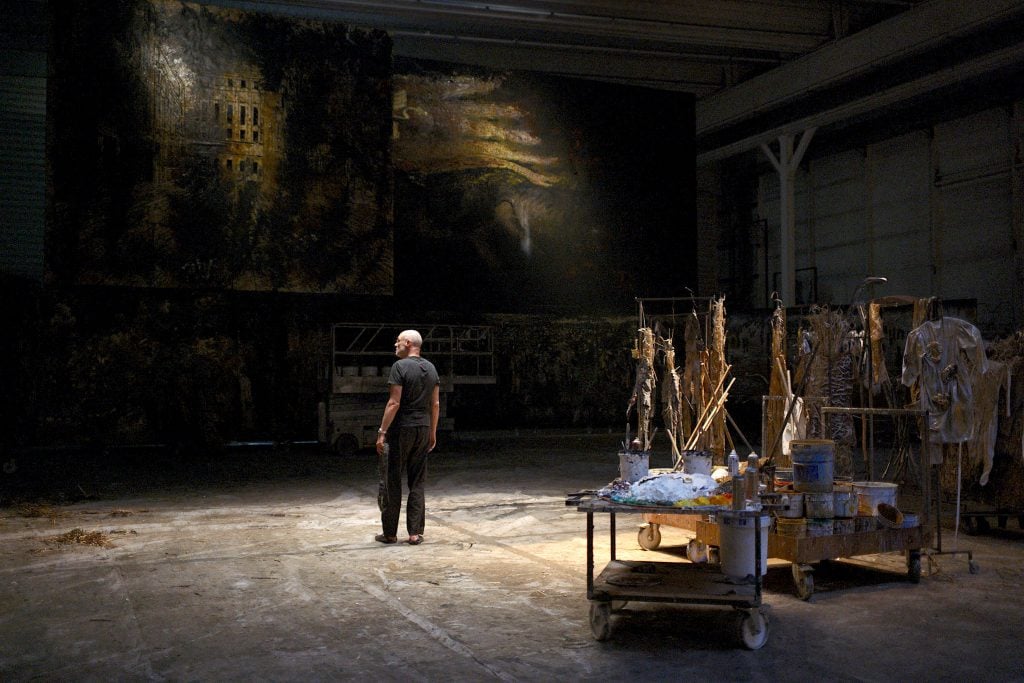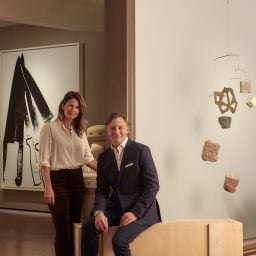The density of Anselm Kiefer’s art goes beyond the physical realm—it delves into symbolic meaning with his diverse processes and working methods, which span the alchemical, the artisanal, and the industrial. His paintings, sculptures, and installations, which frequently deconstruct myth, literature, and history, including the devastations wrought by the Third Reich, are something best viscerally experienced. That is what makes his compatriot Wim Wenders’s 3D documentary Anselm—which is as multi-layered as Kiefer’s canvasses but more playful than one might expect—a lasting gift to contemporary art lovers.
Born five months after Kiefer in 1945, Wenders was a leader of the 1970s New German Cinema movement and his films about existentially challenged wanderers and outcasts—in the likes of Kings of the Road (1976) and The American Friend (1977)—were poetically attuned to the Americanization of West Germany. Others, like Alice in the Cities (1974) and Paris, Texas (1984), reveal a feeling for American landscapes no insider since John Ford had managed.
After living stateside for seven years, Wenders—forever lyricizing tenderness and alienation and the gulfs in between—made the angels-over-Berlin homecoming film Wings of Desire (1987), which remains his masterpiece. If since then his documentaries have received greater acclaim than his fiction, his other 2023 film, Perfect Days, a tranquil drama about a solitary Tokyo toilet cleaner living in a state of grace, is sublime.
In a recent video interview, Wenders discussed his new film dedicated to Kiefer’s life and art—and the German identity and trauma that connects their lives and work.
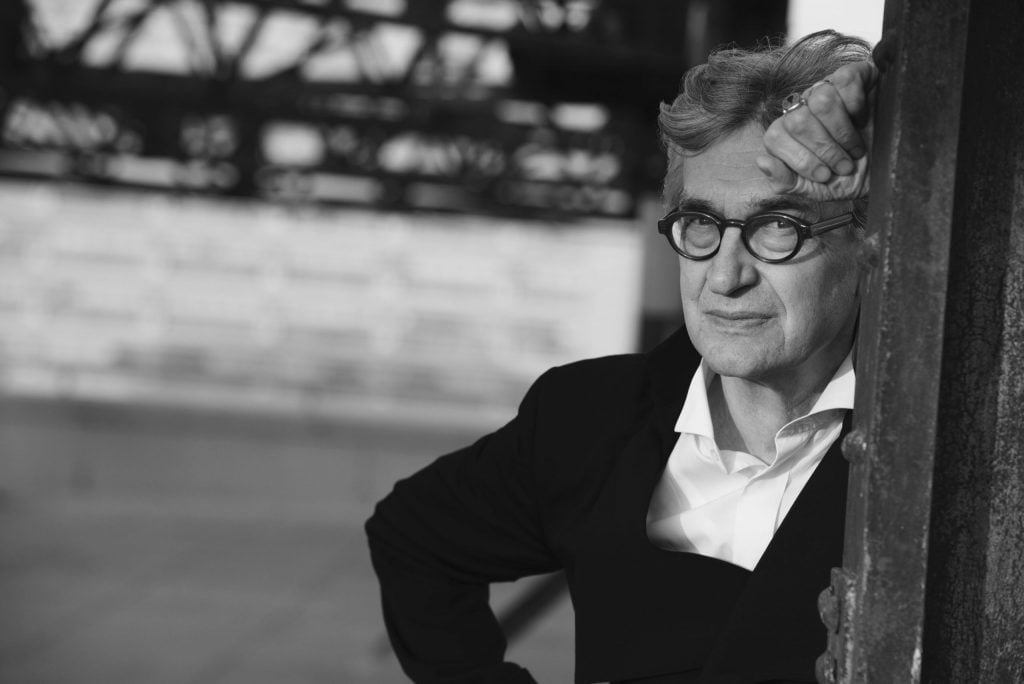
Wim Wenders by Peter Lindbergh (2015)
Do you remember how Anselm Kiefer’s art affected you the first time you saw it?
I first saw his work at Documenta, in Kassel, in the late 1970s. It was amazing—I hadn’t seen anything like it. Joseph Beuys [the artist also presented work that year] was a huge hero to me; and it seemed obvious that Anselm was a student of Beuys, but he seemed to come out of Beuys’s footsteps and take his own path.
The film mentions that after the great triumph Anselm had with his museum shows in America—Chicago, Los Angeles, and at MoMA in New York—he was considered the greatest living artist. And then he came back to his home country and had a big show at the Neue Nationalgalerie in Berlin in 1991—and was crucified. I met him when he was setting it up.
We spent almost three weeks talking and became very close friends. We really told each other a lot. Anselm knew that I had always wanted to be a painter, and I knew that Anselm secretly wanted to make movies—so we shook hands on the idea of making a film together eventually. I’m happy that it took 30 years because I would not have been ready at the time.
You and Kiefer nearly crossed paths at the University of Freiburg, Germany, where you were briefly a medical student in the mid-1960s. In the film, he reflects that he could have met the philosopher Martin Heidegger when he was at that university. The film shows Kiefer turning pages in a book of his paintings that visualize X-rays of Heidegger’s brain gradually being blacked out by cancerous thoughts, as caused by poison mushrooms; he flips past a painting prompted by the Jewish poet Paul Celan’s visit to Heidegger at his mountain hut in Todtnauberg in the Black Forest (July 25, 1967) where Heidegger refused to acknowledge his Nazism—were you aware of his party membership when you were a student?
Not at all. It was still “the time of silence” in Germany when people didn’t speak [about Nazism]. We grew up in a country, Anselm and I, that was trying to reinvent itself, and that reinvention was based on the idea that the past didn’t exist.
We talked a lot about the fact that we had the same experiences as kids growing up in school with Nazi teachers. My impulse was one of disgust, and I just wanted to leave. Anselm’s impulse was to put his finger on that past, dig deep, and expose it, to make people aware of the lies and to fight the forgetting. Those were the different crossroads in our lives, I guess.
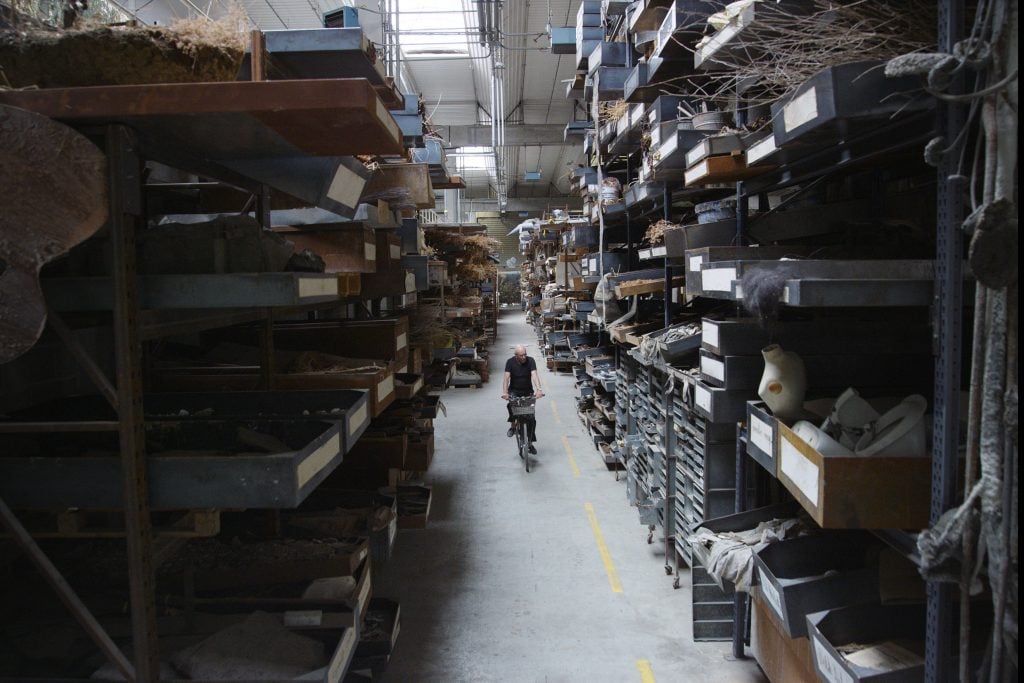
Still from Wim Wenders’s new film Anselm
You use variations on David Caspar Friedrich’s “Rückenfigur” (reversed figure) compositions in your 1975 film Wrong Move, as Kiefer controversially did in his series of staged self-portraits, “Occupations” (1969). You’ve both drawn on Rainer Maria Rilke’s poetry, and you’ve both lived as exiles from Germany. You must feel a strong sense of affinity.
Yes, I do feel that. Part of the reason why I wanted to make this film was to find out about that affinity and how different the art that Anselm has produced was from the films that I made from the same zero hour [a term referring to Germany’s capitulation at midnight on May 8, 1945] we started our lives in.
I’ve always been so curious about his path, especially as I wanted to be a painter. If I enter a painter’s studio, I cannot help but imagine what would’ve happened to me if I had not chosen cinema over painting. Painters for me are still mysterious territory. I feel closer to Anselm than to [other artists] because of our parallels.
The real question in [Anselm] was to find out his impulses and to discover where his unbelievable creative energy comes from. He has made so much work that you cannot fathom it. He thinks anything can be painted—history, mythology, the universe, microcosms, poetry. You name it. I look similarly at the possibilities of filmmaking, but the outcome is so different.
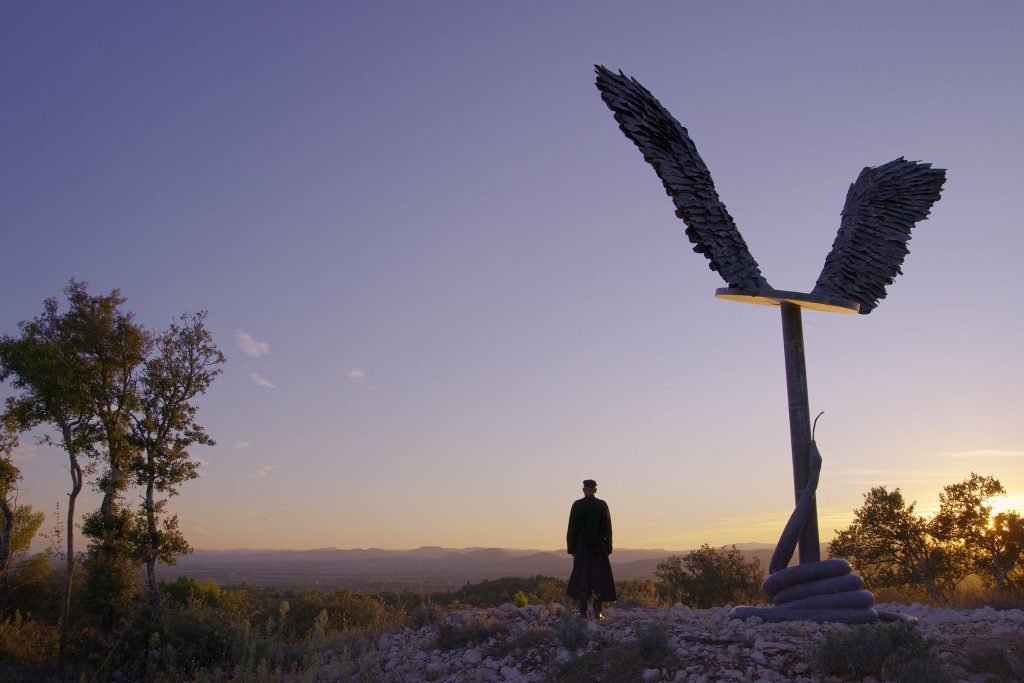
Still from Wim Wenders’s new film Anselm
After making the film Pina (2011) in 3D, was it obvious you should use the technology again to bring out the textures of Kiefer’s work?
I went to Barjac [where Kiefer built his vast La Ribaute studio complex in Gard, southern France] and saw this incredible art landscape for the first time. That’s where I realized it was now or never to do the film that we’d been speaking about.
Seeing its underground galleries, the amphitheater, and all the places he constructed there, I felt I needed a film language that could really take the audience there to experience it the same way I had when I stood there. I felt 3D could do that. Seeing an artist’s work on a flat screen is like going through a catalog, but with 3D you feel you are in front of it. That is such a huge difference, especially where the art is as multilayered and dense as Anselm’s. When you see a movie in 3D, your brain works overtime. You multiply your vision so that it touches areas of your brain that are not usually working, including emotions. I felt I needed that in order to approach Anselm’s universe and dare putting it into a movie.
Watching Kiefer pour molten lead and sear his painters with fire made me think of the character Siegfried forging his sword in Fritz Lang’s Die Nibelungen (1924). It’s as if Kiefer’s very practice of creating art seeks to reclaim the spirit of German and Norse mythology, while exploring how it was misused as propaganda by the Nazis. But sometimes, he reclaims heroic archetypes, then threatens to burn them. His approach to mythology is ambiguous.
Nowhere more so than in Germany. When Anselm first showed works like [the 1978 woodcut collage] Ways of Worldly Wisdom: Arminius’s Battle, people had no other way to understand them than to say he must be a neo-Nazi, even though it was his intention to show all the art that had been abused by the Nazis. They didn’t get that he was freeing that art from the burden that the Nazis had imposed on it and from the lies they told in order to claim German history.
Suddenly, poets [represented in the aforementioned collage, including Annette von Droste-Hülshoff, Stefan George, and Heinrich von Kleist] had become nationalist treasures that they never were before. Anselm got bashed for opening that Pandora’s box. At the time, only Beuys defended him.
Now, I think there is a common understanding that Anselm did a gargantuan work of laying open German history and freeing it of that burden of abuse. Even though his work is often reduced to that [by critics] it didn’t end there, because he went into Greek and Jewish mythology and continued his work in a bigger way.
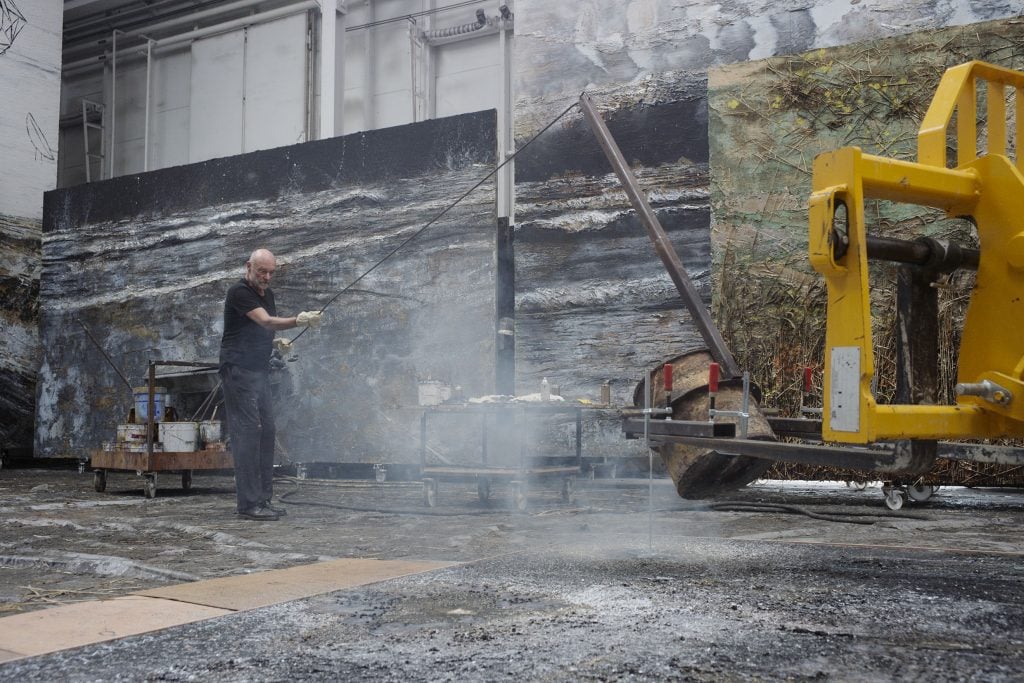
Still from Wim Wenders’s new film Anselm
The film itself is a mutating artwork—a cyclical montage with recurrent themes and visual rhyme; there are imaginary reenactments featuring Kiefer’s son Daniel playing his father and your grandnephew Anton playing Kiefer as an eight-year-old. You chronicle Kiefer’s career via visits to his different ateliers over the years; you travel with him to Doge’s Palace in Venice where he had a groundbreaking show during the 2022 Biennale. You juxtapose earlier documentary footage with elements from Kiefer’s paintings in the same frame. You show Kiefer reclining in a recreation of Vincent van Gogh’s bedroom in Arles, France, and you capture him using a giant dead sunflower stalk to balance as he walks a tightrope above the ruins of Berlin. Your layering echoes the stratification in Kiefer’s art.
That was my intention from the beginning, but it seemed an insurmountable amount of work and I didn’t know how to put this huge puzzle together. Altogether, I made seven visits [to Anselm], each for a week or ten days, and after each visit I edited for weeks and months—for almost three years altogether. After each long editing phase, I knew another part of the puzzle that I wanted to uncover because the material told me what I needed.
In the beginning, I had no idea I was going to reenact the time when Anselm was an unknown painter. Not a single art historian, gallery person, or art critic ever visited him in the first ten years [from 1971 when] he was living as an unknown painter in the Odenwald [south-west Germany]. But in those ten years, he laid the foundations for the body of his work, so I realized I had to shed some light on that time.
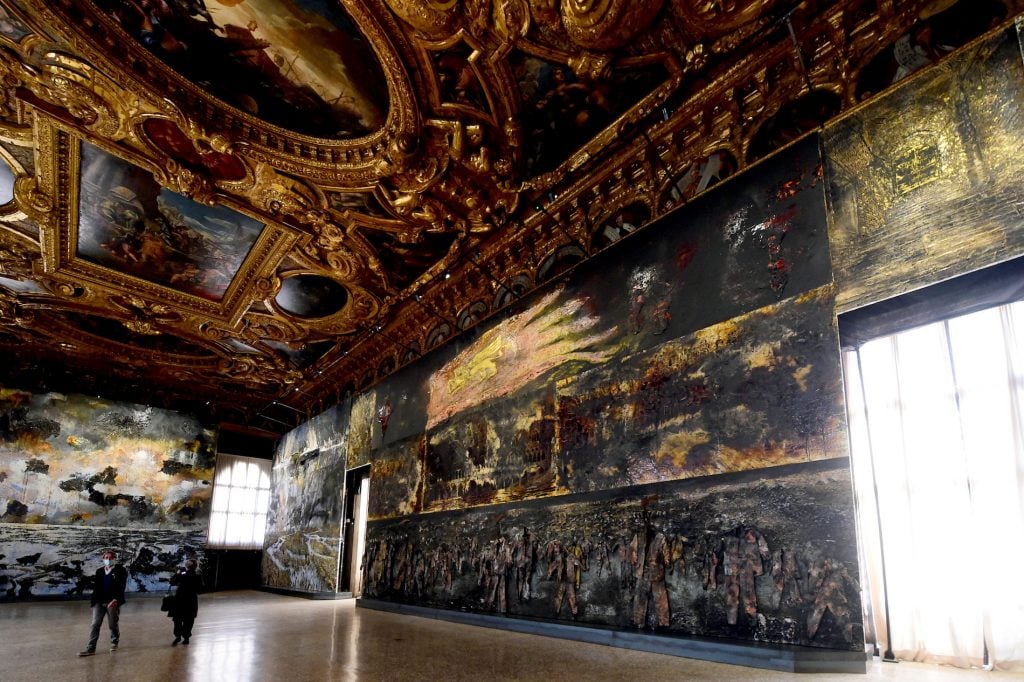
German artist Anselm Kiefer “These Writings, When Burned, Will Finally Give Some Light” exhibition during the preview at Palazzo Ducale on March 25, 2022 in Venice, Italy. (Photo by Roberto Serra – Iguana Press/Getty Images)
As Daniel was the only source I had to describe that time for me—as a boy, he was always sitting under Anselm’s easels and was on the back of Anselm’s bicycle when Anselm pedaled around taking photographs—I eventually said to him: “You’ve told me so much about that part of your father’s life, I’d like to ask you to play him.” Daniel said, “Oh, no, I’m not an actor. How can I? And first I’d have to ask my dad for permission.” I said, “No, you’re not going to ask Anselm,” because Anselm had made only one demand from me. He’d said, “Promise me that you will surprise me with the film.” [When Daniel agreed to play him] I had the chance to do that, so we slowly advanced.
For the last chapter, I felt I had to include the eight-year-old Anselm in the film. The wealth of his imagination derived from the fact that he grew up in Germany in the 1940s and ‘50s, so I had to tap [into] that. The more I shot with Anselm, the more I realized he’s one of the few people I’ve met who has kept the child in him alive.
What was his reaction when he saw the film?
He sat alone in the first row and didn’t say anything for two minutes. I was scared shitless, because: what did this mean? His first line was, “You did surprise me.” And then he said something very funny: “A lot of people will love this film, especially people who don’t know me, but also my critics.”
Does that mean they are coming around to his perspective on German history?
No, he meant they will see their prejudices confirmed.
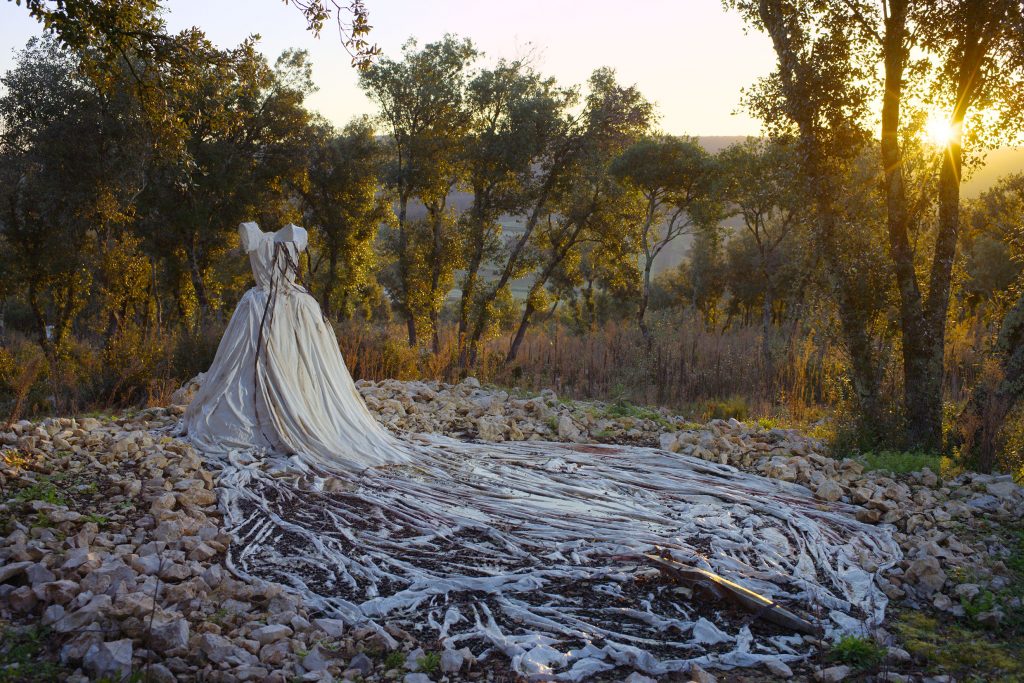
Still from Wim Wenders’s new film Anselm
Kiefer’s forest paintings, such as Varus (1976) and Winterwald (2010), and the paintings inspired by the poems of Paul Celan and Ingeborg Bachmann, evoke the charnel house Europe became during World War 2, a history that should never have happened. Should we feel guilty about admiring their terrible beauty?
Celan’s father and mother died in a concentration camp [in Transnistria Governorate, Romania], so the truth he found is shaped in words shaped from suffering. And you never have to feel guilty for finding beauty in truth, I feel.
Celan and Bachmann confronted the beast in their poetry. Anselm calls them his allies. I knew their poems a little, but not so well. But going deeply into Celan’s “Todesfugue” [“Death Fugue,” (1948), which inspired Kiefer’s Your Golden Hair, Margarete (1980)], I realized there was a key for the entire [Nazi era] in this poem.
I wanted it in the film, but it seemed extremely difficult to do that. I often told myself, “People will leave the theater when they have to listen to it. They won’t be able to cope with it.” But these poets spoke up so courageously, used language so exactly, with so much inner suffering, that I knew [Celan’s own 1958 “Todesfugue” recording] had to be heard in full. Anselm went through the same pain in confronting the horror in his work as he put up a mirror to the Germans’ culture of forgetting, so I’m very proud that people now sit through it. The theater is always silent when they hear the poem, but they stay there, and they realize it’s necessary to come to terms with that time.
You show footage from 1945 of women working in the rubble of German cities, beginning the process of rebuilding the nation, echoing the figure of Trümmerfrauen [translated: rubble women] Kiefer introduced at his Höpfingen brickworks atelier in 1991. We also see his “Regina Coeli” (“Women of Antiquity”) figure (2010), who carries a model of the planets on her shoulders—or, perhaps, the weight of the world. You juxtapose her with a shot of Kiefer standing by a river carrying his younger self on his shoulders. There’s harmony in that—he chose to carry Germany’s burden in his art.
That image is synonymous for me with the image of saint Christopher carrying Christ on his shoulders. It wasn’t written that way. I had Anselm stand by the river and had the little boy stand by the same river in a dreamlike sequence where time disappears. When they were there together, it was an intuition to say, “Anselm, can you imagine putting the boy on your shoulders?” And when he did that, I felt that hot feeling in my heart that this was the scene I had meant to shoot, and I realized that was the end of the film.
It’s a hopeful image because the child is still innocent. It brought out my central idea of Anselm that he managed to remain a child—and that only with the protection of that child in him was he able to do all that he did.
More Trending Stories:
Artists to Watch This Month: 10 Solo Gallery Exhibitions to See In New York Before the End of the Year
Art Dealers Christina and Emmanuel Di Donna on Their Special Holiday Rituals
Stefanie Heinze Paints Richly Ambiguous Worlds. Collectors Are Obsessed
Inspector Schachter Uncovers Allegations Regarding the Latest Art World Scandal—And It’s a Doozy
Archaeologists Call Foul on the Purported Discovery of a 27,000-Year-Old Pyramid
The Sprawling Legal Dispute Between Yves Bouvier and Dmitry Rybolovlev Is Finally Over
